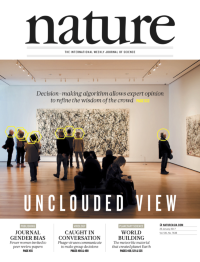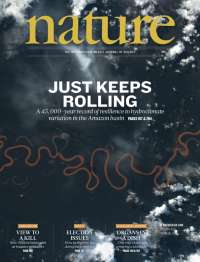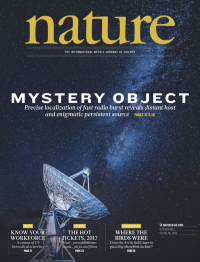Volume 541
-
No. 7638 26 January 2017
The cover shows Jackson Pollocks painting One: Number 31, 1950 in the Museum of Modern Art in New York. The wisdom of the crowd approach has been widely adopted in recent years as a democratic way of determining a truth, fuelled in part by an enthusiasm for online voting procedures. But the crowd is not always correct and can actually be unwise, partly because specialized knowledge is often not widely shared. Here Draen Prelec and colleagues combine the virtues of a democratic algorithm, allowing anyone, irrespective of credentials, to register an opinion, with an elitist outcome that associates truth with the judgements of a few experts. The strategy is based on selecting the answer that is more popular than people would predict, rather than relying solely on most popular or most confident answers. Cover: Shutterstock.
Advertisement Feature
-
No. 7637 19 January 2017
Aerial view from hot-air balloon over a desert grassland in the Namib Rand game reserve in Namibia. Desert grasslands in parts of Namibia are punctuated by regularly patterned patches of bare soil known as fairy circles, the origins of which have remained unclear. Corina Tarnita, Juan Bonachela and colleagues use theoretical modelling and image analysis to show that a combination of scale-dependent feedbacks between plants and territorial competition between subterranean social-insect colonies can explain these features. They conclude that multiple mechanisms of self-organization are probably at play in ecosystems across the world. Cover: Lee Frost/Robert Harding/Getty Images.
-
No. 7636 12 January 2017
An aerial view of the river Amazon, taken from the International Space Station, on 6 April 2016. The Amazon forest both responds to and drives much of the variability in climate and biogeochemistry from annual to millennial time scales. But highly resolved records of past climate variability in the region are hard to come by, and until now it has not been clear even whether the Amazon forest was wetter or drier during the Last Glacial Maximum (LGM). Xianfeng Wang et al. have now collected oxygen isotope data covering the past 45,000 years from stalagmite calcite deposits in the Paraíso Cave in eastern Amazonia. Their data show that rainfall was about half that of today during the LGM (around 21,000 years ago) but was some 50% greater during the mid-Holocene (6,000 years ago), broadly coinciding with global changes in temperature and carbon dioxide. Although the Amazon was drier during the glacial period, the rainforest persisted throughout. Whether or not it can be sustained in the future, however, remains an open question. Cover: Tim Peake/ESA/NASA/Getty Images
-
No. 7635 5 January 2017
The Milky Way and a Karl G. Jansky VLA dish antenna in Socorro, New Mexico. Shami Chatterjee et al. report the subarcsecond localization of the Arecibo-discovered fast radio burst FRB 121102, the only known repeating burst source, using high-time-resolution radio interferometric observations that directly image the bursts. FRBs are radio flashes of unknown physical nature with durations of milliseconds. Previous observations have lacked the resolution to uniquely identify a host or multi-wavelength counterpart. The localization of FRB 121102 reveals a persistent radio and optical source that is coincident with the bursts to within 100 milliarcseconds. The enigmatic persistent source could be a neutron star within its nebula in a distant host galaxy, a low-luminosity active galactic nucleus, or a previously unknown type of extragalactic source. Cover: Michael Spain / 500PX/National Geographic Creative.




